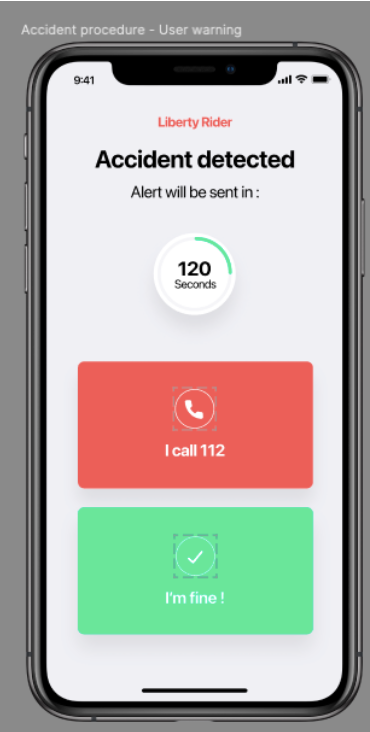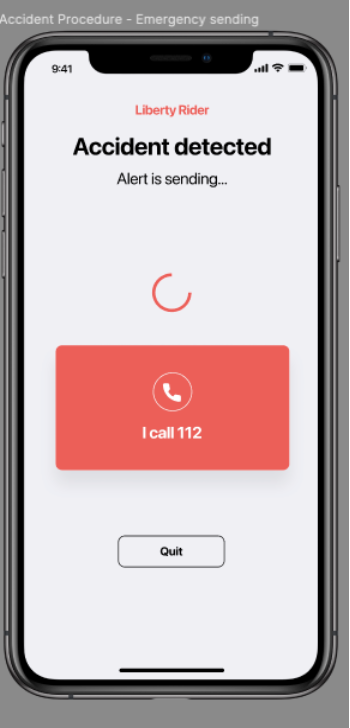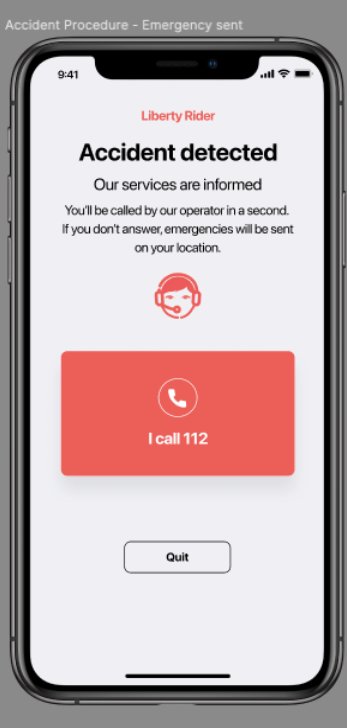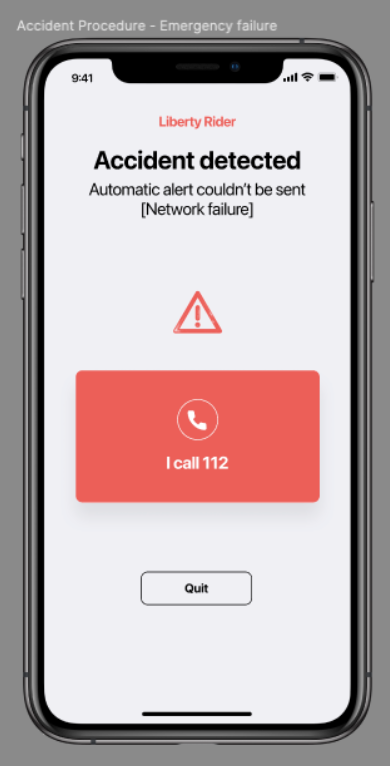User Interface Specification¶
Overview¶
This section is a functional specification from a user point of view. The goal is to provide information on screens displayed when an accident occurs. It provides a list of behaviors after actions, and specific cases.
These behaviors are implemented in the default screens included in the SDK. You can optionally disable this user interface and develop your own.
Here is an overview of the accident screens:
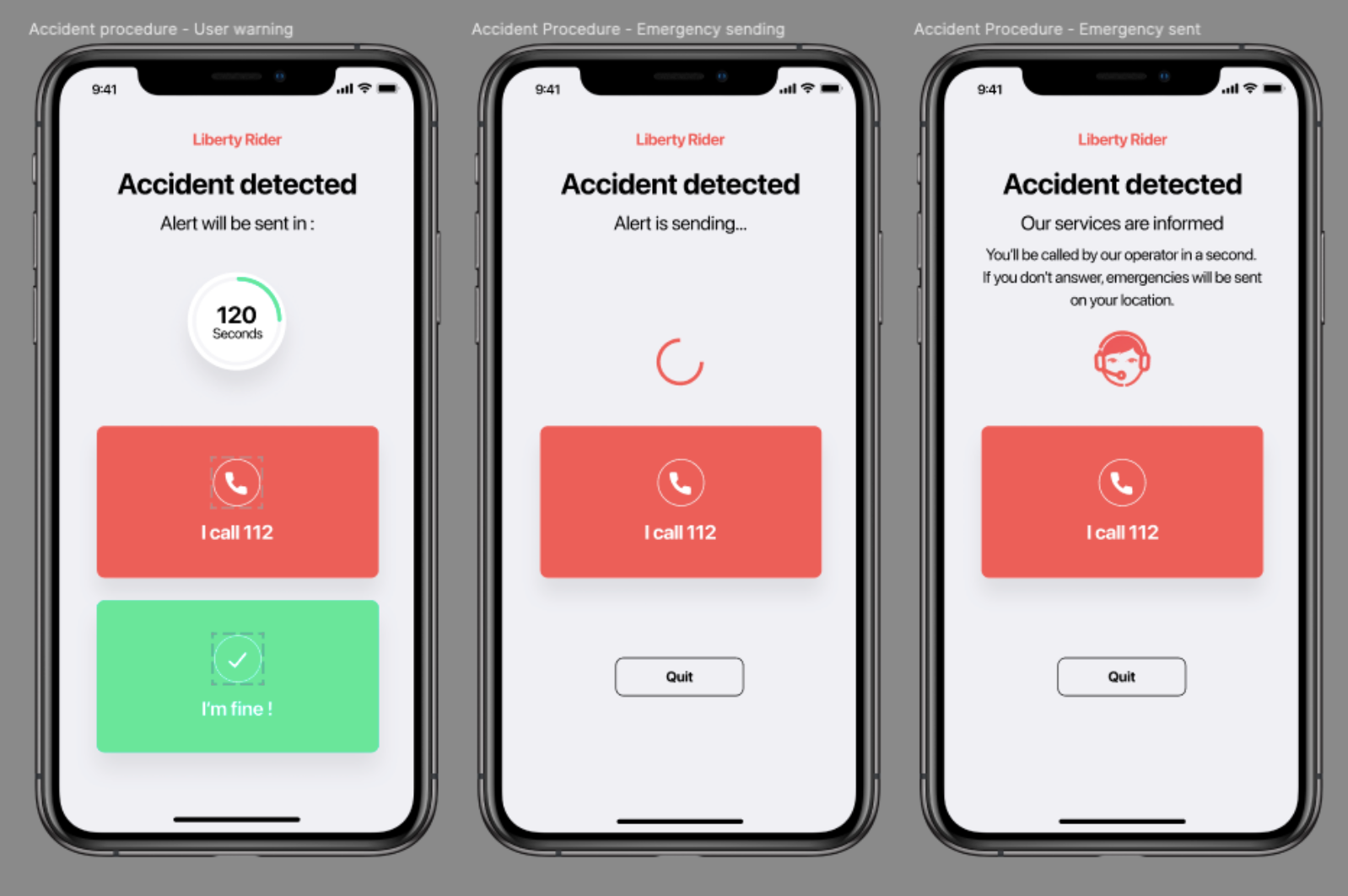
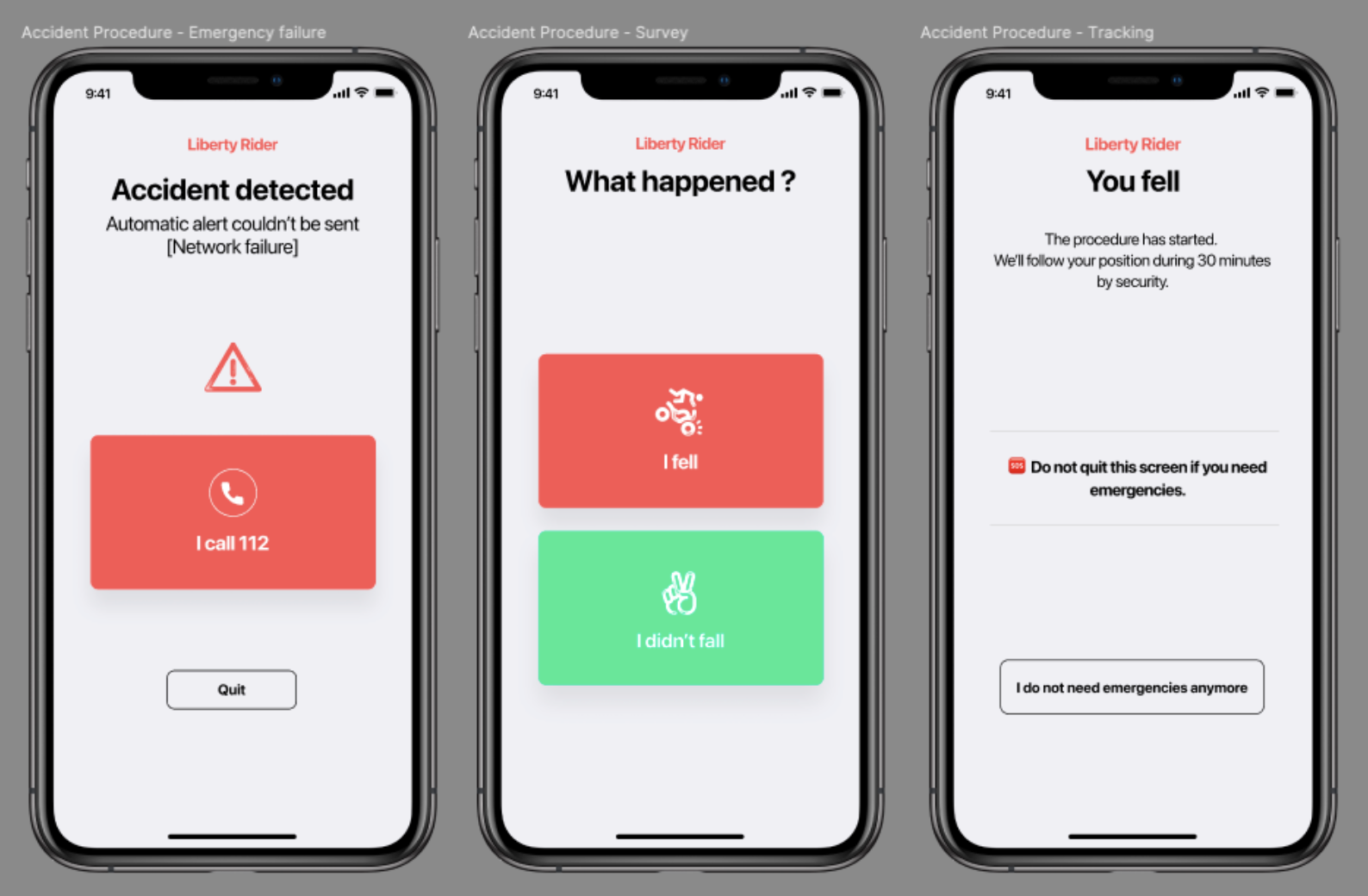
How to Add Custom Accident Screens¶
You would usually want a generic process to start when an accident is detected, as detailed in the Typical App User Stories section. If this is sufficient, you don’t need to implement any user interface yourself : it is already included in the SDK and you can skip the whole section.
If you need more control though, the SDK status updates give you all the events and data you need to implement custom screens or user interactions tailored to your use case.
The code would roughly consist in subscribing to the SDK status updates (documented in previous sections), computing a “workflow state” to determine which screen to show, and calling the relevant SDK methods when the user interacts with the custom screens. Below are examples of how you can compute a “workflow state” to determine which screen to show.
Android UI State Example¶
enum class EmergencyWorkflowState {
NO_EMERGENCY, ALERT_COUNTDOWN, EMERGENCY_SENDING, EMERGENCY_SENT, EMERGENCY_SENDING_FAILED, EMERGENCY_ENDED
}
override fun onStatusChanged(status: LRProtectionStatus) {
val state: EmergencyWorkflowState = when {
status.alert != null ->
EmergencyWorkflowState.ALERT_COUNTDOWN
status.emergency != null && status.emergency.hasEmergencySendingFailed ->
EmergencyWorkflowState.EMERGENCY_SENDING_FAILED
status.emergency != null && status.emergency.isEmergencySending ->
EmergencyWorkflowState.EMERGENCY_SENDING
status.emergency != null && status.emergency.isEmergencySent && !status.emergency.isEmergencyEnded ->
EmergencyWorkflowState.EMERGENCY_SENT
status.emergency != null && status.emergency.isEmergencyEnded && status.emergency.isEmergencySent ->
EmergencyWorkflowState.EMERGENCY_ENDED
else -> EmergencyWorkflowState.NO_EMERGENCY
}
}
iOS UI State Example¶
enum EmergencyWorkflowState {
case noEmergency, alertCountdown, emergencySending, emergencySent, emergencySendingFailed, emergencyEnded
}
func protectionStatusDidChange(_ status: LRProtectionStatus) {
var state: EmergencyWorkflowState
if status.alert != nil {
state = .alertCountdown
} else if let emergency = status.emergency {
if emergency.isEmergencySending {
state = .emergencySending
} else if emergency.hasEmergencySendingFailed {
state = .emergencySendingFailed
} else if emergency.isEmergencySent {
state = .emergencySent
} else if emergency.isEmergencyEnded {
state = .emergencyEnded
}
} else {
state = .noEmergency
}
}
Workflow States :¶
Here is a description of each of the workflow states:
NO_EMERGENCY / .noEmergency¶
The protection is inactive, or the protection is active and no accident has been detected yet. There is nothing to show.
ALERT_COUNTDOWN / .alertCountdown¶
This state refers to US#2 - Start an Accident Process
An accident has been detected and you should display the countdown screen to the user based on the alert properties. In this state, the user should be able to stop the alert countdown by calling stopAlertCountdown() if they don’t want any assistance. If there is no user interaction and the countdown ends, the next state will be EMERGENCY_SENDING.
EMERGENCY_SENDING / .emergencySending¶
This state refers to the first variant of US#3 - Emergency Request
This state means that an accident has been detected, the user has not stopped the alert countdown, and it’s time to send an emergency to SafeRider servers. In this state you should tell the user that we are currently trying to send the emergency through the network. Barring any user interaction action the next state will be EMERGENCY_SENT or EMERGENCY_SENDING_FAILED.
EMERGENCY_SENT / .emergencySent¶
This state refers to the second variant of US#3 - Emergency Request
SafeRider servers have received the emergency and our operators will now take care of the user.
In this state you should allow the user to cancel the emergency by calling cancelEmergencyRequest(). Without any user interaction the next state will be EMERGENCY_ENDED after 30 min of user location tracking.
EMERGENCY_SENDING_FAILED / .emergencySendingFailed¶
This state refers to the third variant of US#3 - Emergency Request
The SDK wasn’t able to send the emergency to SafeRider servers due to network or server issues. It usually takes 15 min without any network connection to reach this state. You should still allow the user to contact emergency services by calling 112 themself.
EMERGENCY_ENDED / .emergencyEnded¶
An emergency has been processed and post-accident tracking has ended (it usually lasts 30 min, to allow emergency services to follow the user). Now you can quit the emergency workflow by calling resumeProtectionAfterEmergency(), then the next state will be NO_EMERGENCY, meaning that neither alert countdown or emergency is ongoing.
US#1 - Start a Protection Session¶
As a user, I want to start a protection session
Title |
Description |
|---|---|
Intro |
To start a protection session you call the |
Phone Number |
A valid phone number should be available locally and is mandatory to start a protection session.
E.164 format (international prefix), eg: +XX 1234567890
|
Name |
The full name of the user should be stored locally and made available before session start. |
Country |
Actual countries where the service is available depend on your contractual terms with Liberty Rider. Emergency services vary by country, so a dedicated line with operators has to be opened for each language and zone. |
Location Permission |
The app needs permission from the OS to access the device location.
The exact permission needed depends on your platform (Android/iOS) and is explained in another section.
You may ask for this permission beforehand (eg: right after installation).
Yet you should check one last time before starting a protection session that the permission is still granted ; and ask again if it isn’t.
|
US#2 - Start an Accident Process¶
As a user, I want the accident process to start when I fall
US#3 - Emergency Request¶
As an injured user, I want my emergency request to be sent, so I can be handled by emergency services if I can’t move.
US#4 - Call 112 Manually¶
As a conscious user, I want to call 112 by myself, to keep control over my caring
Title |
Screen |
Description |
|---|---|---|
Call 112 |
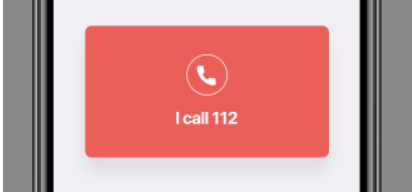
|
At click on ‘Call 112’
- Stop the alert sound and vibration
- Emergency request process keeps running unaffected
- The platform “Start a phone call” modal is opened to dial 112.
|
US#5 - Quick Survey to cancel the Emergency¶
As a user, I want to cancel the emergency if I did not fall.
As a user, I want to confirm that I fell.
